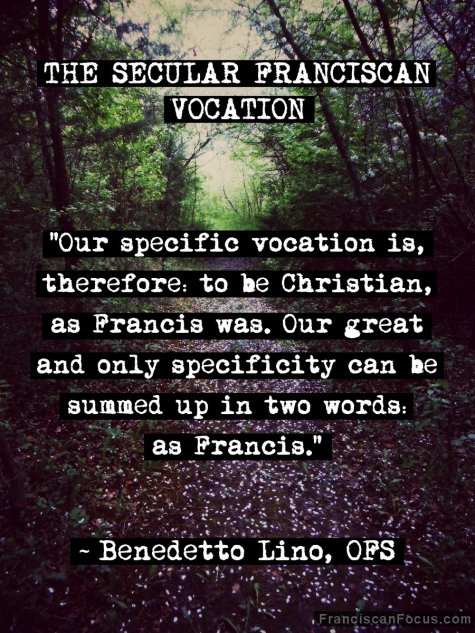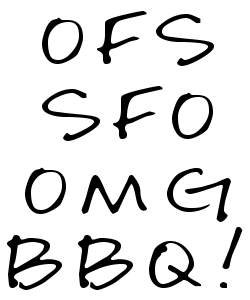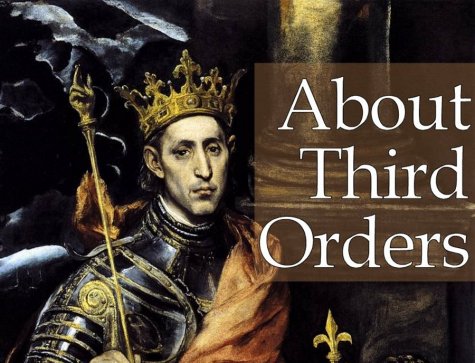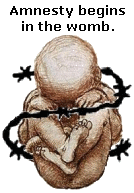The Secular Franciscan Vocation

When folks learn I'm a Franciscan -- specifically, a
Secular Franciscan -- the inevitable question I get is, "So, what do you
do?" The thing to understand is that we Franciscans aren't about
doing. We're about
being, and everything that we do flows from that
being.
A few years ago, during our 2011 General Chapter, Benedetto Lino, OFS did a superb job explaining our charism and vocation, so I figgered I'd share a few snippets here with all y'all (all emphases are the author's). :-) Do read
the full thing!
"Without any doubt, our vocation is specific. Indeed, we are not Jesuits, Dominicans, Carmelites or Members of the Focolare Movement or of any other.
"... Our specific vocation is to be Franciscan and secular and, as such, it is directly dependent on Francis of Assisi and his vocation. His example and his life have attracted us. God used him to lead us to a specific form of life. So we must turn to and start from Francis if we are to understand our own specific vocation.
"... [Our vocation] is specific only because our call refers to an example, a model, a unique way of following Francis of Assisi. This is the true and the only specific element of our vocation that distinguishes us and unites us: to be total Christians, as Francis was.
"... Our specific vocation is, therefore: to be Christian, as Francis was.
"Our great and only specificity can be summed up in two words: as Francis."
~ Benedetto Lino, OFS, "A Specific Vocation for a Particular Mission" (PDF)
Labels: franciscan, ofs, vocations
What's with the "OFS" and "SFO" after your name?

If by some strange sickness, you go lookin' through older posts and comments here, you'll see the acronym "SFO" after my name. However, more current ones have "OFS". Any normal person would see this and say, "Huh?" So, I 'splain it for you.
Folks in orders (religious
and seculars) put their orders' acronyms after their names to indicate their membership in said orders. For example, "Brother John Smith,
OP" indicates that he's a member of the
Order of Preachers (Ordo Praedicatorum, "OP"). "Sister Jane Doe,
FSP" indicates she's a member of the arse-kickingly awesometastical
Daughters of Saint Paul (Figliae Sancti Pauli, "FSP").
As you can see in these examples, the abbreviations correspond with the
Latin form of the names. That way, everyone, regardless of country/language, has the same acronym, which emphasizes the universality of the order and has the side benefit of reducing confusion.
Now, for those of us Secular Franciscans in
English-speaking countries, we
used to list the
English abberviations -- "SFO" for "
Secular Franciscan Order" -- after our names. However, everyone
else used the proper "OFS" -- for
Ordo Franciscanus Sæcularis -- after their names. And as you can imagine, it caused continual confusion, along with fragmenting our identity.
Finally, late last year (2011), Rome said*, "Hey, enough! Use 'OFS' like everyone else!", which was A Very Good Move. So, since then, we've all been switching to "OFS". Naturally, it's taking awhile for the changes to propagate everywhere, so you'll still see "SFO" references and stuff all ova' the place. But, we'll get there, eventually. We've been around since 1221, so yeah, we're used to adapting. ;-) Oh, bonus trivia tidbit: We were orignally called "The Brothers and Sisters of Penance".
So, now you know. And knowing is half the battle. Go forth and win at Trivial Pursuit!
- - - - -
* Ordo Franciscanus Sæcularis,
2011 General Chapter: "The Official Name of the Order" (PDF)
Labels: ofs, third orders, vocations
Catholicism's best-kept secret: Third orders

Image detail from St. Louis King of France with a Page by El Greco (1590). King St. Louis IX was a Secular Franciscan and is the co-patron of the Secular Franciscan Order.
Click here to save this post on Pinterest.
Are you a Catholic who feels attracted to a religious order, but are married? Do you want to stay in your home and at your job, but still follow a rule of life, like that of St. Benedict, for example? Do you want to share your pilgrim journey with other like-minded people? Have I got a deal for you: Third orders!
What are Third/Secular Orders?
According to the
New Advent Catholic Encyclopedia, "Third Orders signify in general lay members of religious orders, i.e. men and women who do not necessarily live in community and yet can claim to wear the habit* and participate in the good works of some great order. ... Any Catholic may join a Third Order, but may not at once belong to more than one, nor may he without grave cause leave one for another."
(* I can't speak for others, but we Secular Franciscans do wear habits.)
Here's the
Code of Canon Law's definition: "Associations whose members share in the spirit of some religious institute while in secular life, lead an apostolic life, and strive for Christian perfection under the higher direction of the same institute are called third orders or some other appropriate name." (Can. 303)
For more information, see the following general resources:
Who Joins Third/Secular Orders?
Married or single Catholic women and men from all walks of life are able to join secular orders, as are diocesan priests and deacons. Like their religious counterparts, seculars (also called "tertiaries") undergo a period of formation according to the processes established by their orders, after which they become professed members. Profession for seculars means they promise to live according to the rules of their orders; it does
not consist of taking vows.
What Does "Secular" or "Third" Order Mean?
Unlike religious (monks, friars, nuns, sisters) who remove themselves from the world and live apart in convents or friaries, those in third orders stay where they're at in the world (homes, jobs, families, etc.); hence, the term "secular". For example, as Bernard of Bessa, Secretary of St. Bonaventure, said, "The intention of [Secular Franciscans] is to live honorably in their residences and to busy themselves with pious actions and to flee from the vanities of the world."
You also see "third" used, a term which arose as an indicator of when the lay branch of the main order was established. For example, the
Franciscan Order started with a group of men, whom St. Francis of Assisi organized into the Order of Friars Minor -- the
first order. After a time, a
second order for nuns -- the Poor Clares -- was established. Finally, a
third order was established for the laity -- the Secular Franciscan Order.
Links for Third/Secular Orders
Last updated 16-Jul-2014
If you'd like to learn more, check out the following links. I'm not sure that everything listed meets the criteria of being an actual third/secular order, but it's at least something to look into! Also, while oblates are not technically tertiaries, I've included them here, since they're still a way for laity to associate with religious orders. :-)
Please feel free to share any information, or corrections, you may have in the comments.
NOTE: Some of these sites are NOT in full compliance with the Church's Magisterium, so please exercise caution when surfing. I've included them for contact/informational purposes; it doesn't necessarily mean I endorse 'em!
Labels: third orders, vocations




 If by some strange sickness, you go lookin' through older posts and comments here, you'll see the acronym "SFO" after my name. However, more current ones have "OFS". Any normal person would see this and say, "Huh?" So, I 'splain it for you.
If by some strange sickness, you go lookin' through older posts and comments here, you'll see the acronym "SFO" after my name. However, more current ones have "OFS". Any normal person would see this and say, "Huh?" So, I 'splain it for you.
